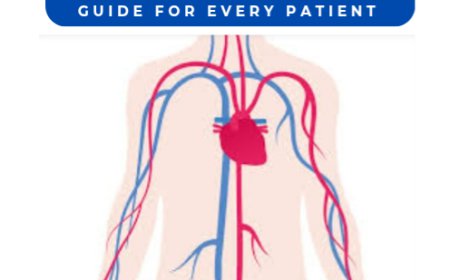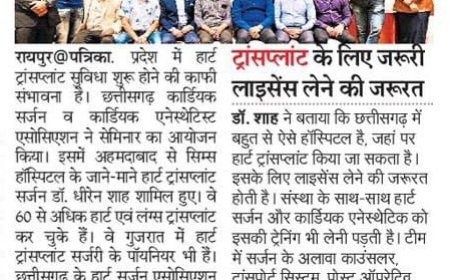One Step Ahead – How OT Nurses Can Support Cardiac Surgeons Proactively in Surgery
“One Step Ahead” – How OT Nurses Can Support Cardiac Surgeons Proactively in Surgery by Dr. Dhiren Shah

“One Step Ahead” – How OT Nurses Can Support
Cardiac Surgeons Proactively in Surgery
A Practical Guide for Cardiac OT Nurses
Inspired by the standards of Dr. Dhiren Shah, Senior Cardiac Surgeon, Marengo CIMS Hospital, Ahmedabad
Introduction: The OT Nurse as the Surgeon’s Most Trusted Ally
Cardiac surgery is high-stakes, high-pressure, and highly coordinated. While the surgeon performs the operation, a skilled OT nurse ensures that the procedure flows without interruption, risk, or delay.
A proactive OT nurse does not simply respond to instructions—they anticipate the surgeon’s needs, spot potential issues early, and maintain a sterile, calm, and focused environment. This guide outlines how to excel in this vital role.
1. Understand the Procedure Thoroughly Before the Case Begins
Know:
-
The exact surgical procedure being done (e.g. CABG, valve replacement, aortic dissection, etc.)
-
The steps of the procedure (e.g. sternotomy, cannulation, graft harvesting)
-
The surgeon’s preferences for instruments, suture types, and order of operations
-
Special patient factors (allergies, blood cross-match, comorbidities, risk profile)
How to be Proactive:
-
Review the surgical plan ahead of time
-
Check if special instruments, grafts, prosthetic valves, or devices are required
-
Confirm availability of blood, cell-saver, and perfusion equipment
-
Communicate with perfusionist and anesthesiologist to stay aligned
2. Prepare the OT Like It’s Your Operation
Must-Do Proactive Tasks:
-
Check functionality of lights, suction, cautery, bypass machine interface, and monitoring lines
-
Ensure correct instrument trays, suture materials, and implantable devices are on table and back-up tray
-
Position the OT table, arm boards, padding, and warming blankets exactly as per surgeon’s comfort
-
Sterilize and double-check all drapes, gowns, and implants
-
Keep a backup set of sutures, blades, and cannulas ready—don’t wait to be asked
Mental Checklist Before Incision:
✅ Anesthesia and monitoring lines secured
✅ ECG leads and defibrillator ready
✅ Cardioplegia and heparin protocol clarified
✅ Sterile field protected
✅ Skin marking confirmed
3. Anticipate the Surgeon’s Needs at Every Step
An experienced OT nurse can often hand over instruments before the surgeon even asks.
Example Points to Anticipate:
-
Before sternotomy: Prepare sternal saw, bone wax, cautery
-
During bypass: Keep cannulas, clamps, and purse-string sutures ready
-
Graft harvesting phase: Have vein harvesting set and ligaclips prepared
-
For valve cases: Know exact valve size, prosthesis type, and handle it gently
-
During emergencies: Keep suction ready, cardiac massage tray within reach, crash cart alert
Stay visually alert to the surgeon’s body language and tone. Fatigue, urgency, or frustration should cue you to act faster or assist more attentively.
4. Be the Surgeon’s Communication Bridge
Key Responsibilities:
-
Inform the surgeon of any equipment failure, delay in perfusion setup, low blood levels, or ECG changes
-
Relay important anesthesia updates when surgeon is deep in procedure
-
Keep sterile time records accurately (heparin time, bypass start/stop, cross-clamp time)
-
Respond clearly and calmly to instructions—even under pressure
Proactive Communication Saves Lives.
5. Manage the Sterile Field Like a Fortress
The heart is exposed during cardiac surgery—any break in sterility can be catastrophic.
Pro Tips:
-
Constantly monitor your own and your colleagues’ sterile technique
-
Promptly correct breaches—don’t be hesitant
-
Never allow unnecessary staff or movement around the field
-
If contamination is suspected—speak up immediately
6. Post-Op Role: Support the Transition Seamlessly
After Skin Closure:
-
Help with line removals, drape removal, and wound dressing
-
Assist in equipment cleanup, safe sample transport, and instrument counts
-
Coordinate with ICU nurse and anesthetist to ensure safe shift-out
-
Double-check patient tags, reports, and consents before leaving OT
7. Build a Partnership Mindset with the Surgeon
Becoming a surgeon’s trusted OT nurse takes time—but proactive behavior builds credibility fast.
Show You’re Invested:
-
Learn from mistakes and improve after each case
-
Ask for feedback directly from the surgeon or senior staff
-
Stay calm in crises—the surgeon takes emotional cues from you too
-
Offer assistance without waiting to be asked (e.g., securing lines, supporting retractors)
8. When Things Go Wrong – Be the Calm in Chaos
In cardiac surgery, unexpected bleeding, arrhythmias, or cardiac arrest can occur.
Your Role in Emergencies:
-
Stay silent unless you're giving or receiving instructions
-
Get necessary equipment immediately (clamps, sutures, extra blood, crash meds)
-
Support the team emotionally by staying composed and focused
-
If you feel overwhelmed, ask for support, but do not panic
9. Documenting Accurately and Thoroughly
Maintain clear, concise, and complete documentation:
-
OT start and end time
-
Details of devices implanted
-
Suture and instrument count verification
-
Any intra-operative complication or deviation
-
Record team names for accountability
10. Qualities of a Proactive OT Nurse
✅ Alert but calm
✅ Fast but precise
✅ Assertive but respectful
✅ Technically skilled and emotionally intelligent
✅ Focused on safety, not just speed
✅ Thinks ahead, not just in the moment
Final Words: The Unsung Hero of Cardiac Surgery
Cardiac surgery is a team effort—and a successful outcome reflects everyone’s excellence. As a proactive OT nurse, you make the procedure smoother, the patient safer, and the surgeon more effective.
“My surgery succeeds not because I’m alone in the theatre—but because I have nurses who think and act with precision, care, and commitment.” – Dr. Dhiren Shah
Your anticipation, preparation, and calm confidence can mean the difference between chaos and control, stress and safety, good outcomes and great ones.
What's Your Reaction?
 Like
0
Like
0
 Dislike
0
Dislike
0
 Love
0
Love
0
 Funny
0
Funny
0
 Angry
0
Angry
0
 Sad
0
Sad
0
 Wow
0
Wow
0
























